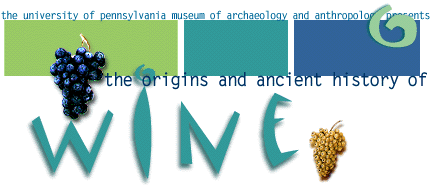It has
usually been argued that barley beer was the alcoholic beverage of choice
in ancient Sumer,
Did
you know...?
Queen
Pu-abi,
who was buried with her servants—who had all been ceremonially
poisoned—was accompanied to the afterlife with hundreds
of gold and silver goblets, drinking-tubes or straws of
lapis lazuli, and a five-liter silver jar, which is thought
to have been her daily allotment of barley beer!
|
|
since the
hot, dry climate of southern Iraq makes it difficult to grow grapevines,
and the textual evidence for viniculture and winemaking in Mesopotamia
is minimal before the 2nd millennium B.C. But based on chemical evidence
for wine inside jars that could've been used to transport and serve it,
wine was probably already being enjoyed by at least the upper classes
in Late Uruk times (ca. 3500-3100 B.C.). Early Dynastic cylinder seals
depict the royalty and their entourages drinking beer with tubes/straws
from large jars and a second beverage—presumably wine—from hand-held
cups.
Did
you know...?
Museum
scientists have analyzed what participants ate and drank
at the final funerary
feast of King Midas at Gordion
(ca. 700 B.C.) and discovered that it was lamb stew and
a mixed fermented beverage of wine, barley beer, and honey
mead!
|
|
The wine
imported into lowland Greater Mesopotamia could have been brought from
the northern Zagros Mountains of Iran or other parts of the Near East,
at least 600 kilometers away. The 5th century B.C. Greek historian Herodotus
describes shipping wine down the Euphrates or Tigris from Armenia at
a much later period: round skin boats were loaded with date-palm casks
of wine and delivered to Babylon. River transport was also an option
in the Late Uruk Period. But if the demand for the beverage were great
enough, transplantation of grapevines to closer locales in the central
Zagros and possibly as far south as Susa would be anticipated. When
the Late Uruk trade routes were suddenly cut off at the end of the period,
the pressure to establish productive vineyards closer to the major urban
centers would have intensified.

A
"banquet" scene on an impression of a lapis cylinder seal from Queen
Pu-abi's tomb. A male and female on either side of a wide-mouthed
jar are shown imbibing barley beer through drinking tubes, while
others below raise high their cups, probably containing wine, which
is served from a spouted jar.
|
Future
excavation will be decisive in tracing the prehistory of viniculture
and winemaking in this region of the ancient Near East; already there
is a strong indication that the domesticated grape plant had already
been transplanted there as early as the mid-3rd millennium B.C. Elamite
cylinder seals, foreshadowing similiar scenes on Assyrian reliefs some
two millennia later, depict males and females seated under grape arbors,
drinking what is most likely wine.
|


